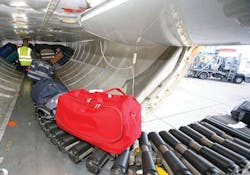Extendable Beltloaders Offer Relief To Baggage Handlers
Airlines, airports and ground handlers are increasingly turning to extendable beltloader technology to improve labor efficiency, reduce turnaround times and lower shoulder and back injuries inside the hold. Several concepts for extendable beltloader technology have been around for nearly 10 years, but acceptance and demand for extendable beltloaders has increased dramatically over the last few years.
To understand the trend, we have to look deeper at the business case for investing in extendable beltloader technology. Extendable beltloaders produce their highest rate of return in any one of the four following scenarios.
1) Narrow-body aircraft gate utilization: The majority of narrow-body aircraft in use today at major airports require two baggage loading personnel to be inside the hold to unload and load. Using extendable beltloader technology eliminates the need for the doorman and, therefore, only requires one person to enter the hold. Highly utilized gates will have two doormen that can be eliminated from the cost structure of the operation.
2) Tight turnaround time combined with heavily loaded aircraft: Airlines and ground handlers that currently use certain types of extendable beltloaders experience as much as a 35 percent decrease in their baggage unloading/loading time. This decrease in time allows operators to provide a quicker turn of the aircraft with the added benefit of doing so with one less person.
3) Aircraft with onboard loading systems: With the cost of aircraft fuel ever increasing, most airlines have come to the realization that reducing the aircraft weight to a minimum is a key component to cost reduction and profitability. Onboard aircraft loading systems can add more than 1,000 lbs to the weight of the aircraft. Studies have shown that removing such systems can save more than $100,000 per year per aircraft in fuel cost. In addition, onboard systems have to be maintained by aircraft maintenance personnel and if a system issue is serious enough, could cause an aircraft to be grounded. Extendable beltloaders provide the same benefits as the onboard systems, but are ground-based and eliminate the costs associated with extra fuel burn and aircraft maintenance issues.
4) Heavy cargo, injuries and an aging workforce: Operations that routinely handle heavy or overweight baggage/cargo experience much higher rates of on-the-job shoulder and back injuries inside the hold. Add to that the fact that the average age of ramp personnel continues to increase due to less turnover related to the current employment market. As we all know, the older we get, the more prone we are to hurting ourselves. Extendable beltloader technology greatly reduces the stresses placed on the human body during unloading/loading inside a hold.
Let’s look at this last information and further discuss injuries. Airline baggage handler injuries cost millions of dollars annually. Incidences of lost time due to back and shoulder injuries in the airline industry are some of the highest in all of private industry.
A baggage handler in a typical airplane is akin to a coal miner. In fact, according to the U.S. Bureau of Labor Statistics, the incidence of back pain injury for “air transport, scheduled,” (in other words, “airline passenger service”) exceeded that of coal mining and almost all other industries for which the bureau maintains statistics.
The ceiling height for a Boeing 737 cargo hold is 44 inches, which naturally forces baggage handlers to work continuously in squat, stooped, kneeling or seating postures and often handle luggage at or above shoulder level. On average, a piece of luggage weighs 33 lbs, but many bags weigh more than 70 lbs. This load exceeds the National Institute for Occupational Safety and Health’s lifting equation limit for working in optimum working postures and conditions.
Other researchers examined the option of enforcing a specific weight limit for luggage, but unless this was adopted by all countries and airlines simultaneously, those that adopted such a rule would be at a competitive disadvantage.
A literature review published in 2009 by the Health and Safety Executive, an organization in the United Kingdom similar in some cases to this country’s Occupational Safety and Health Administration, presented a litany of information related to alternative methods of loading narrow-bodied aircraft that reduced injury to baggage handlers.
HSE surveys provide plenty of evidence that baggage handling is physically demanding:
- 73 percent of baggage handlers reported trouble with their lower back.
- 51 percent reported trouble in their knees.
- 43 percent reported trouble in their shoulders.
The report highlights a range of existing and emerging devices providing mechanical assistance (and manual handling risk reduction), to the baggage handling process.
“There is good evidence for the benefit of mechanical assistance devices in terms of reducing physical workload, manual handling and musculoskeletal risks associated with baggage handling work on the ramp,” the report concluded.
Most of the definitive work in this area was done by researcher G. Dell. Dell reviewed the manual handling activities of ramp-based workers and presented evidence that each item of passenger baggage is typically manually handled up to 10 times for each journey (up to five times at each end.)
Interestingly, the HSE notes, in a section on the history of the airline baggage handling, Dell presents images of operations from 1926; 1940; 1955; and 2000. “The nature of the manual operation has not changed significantly, although the amount of air travel, and, hence, the extent and frequency of the baggage handling operation has increased,” the report says.
When adverse work conditions exist, engineering means of changing the condition should be explored.
Extendable beltloaders reportedly significantly reduce the amount of manual exertion, lifting and supporting involved in the stacking and unstacking of luggage. No system does away with the fact that the baggage handler needs to kneel, sit or squat in the confines of a hold. However, it is the combination of heavy handling while in a kneeling posture that presents the greatest risk of injuries on the job.
